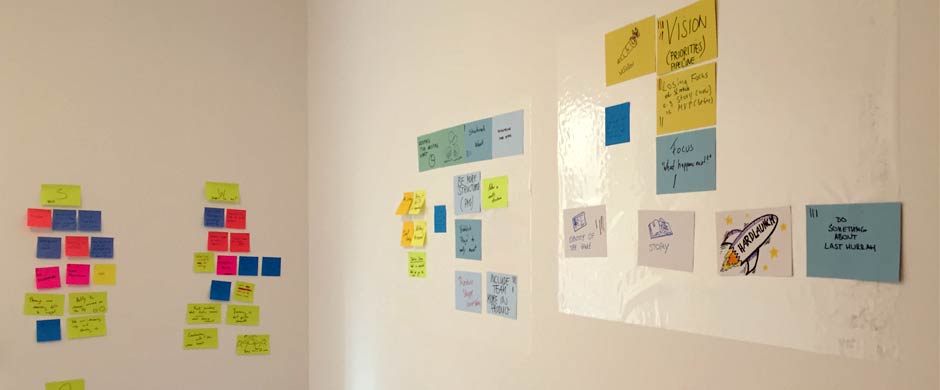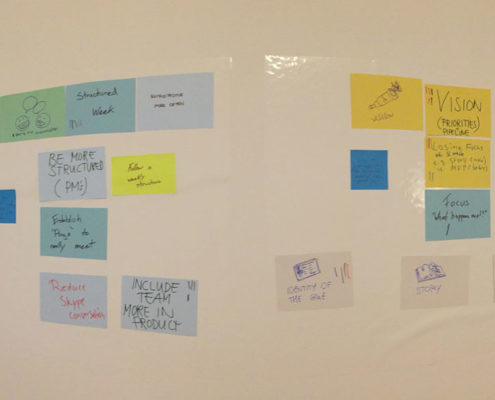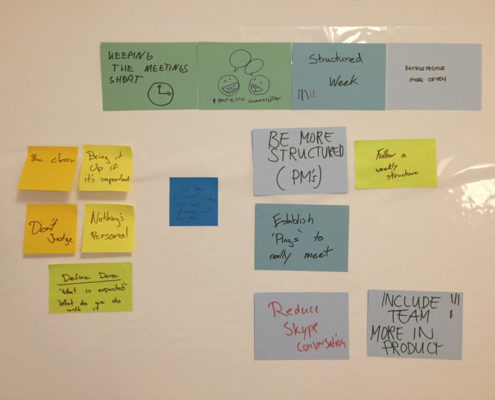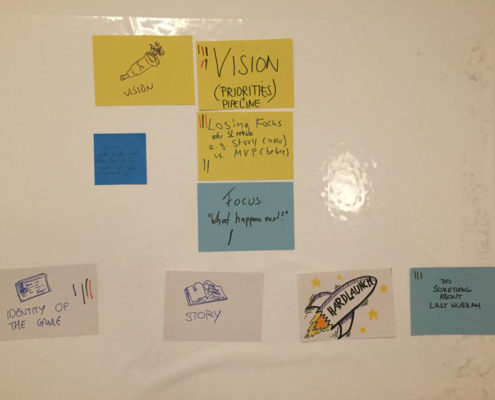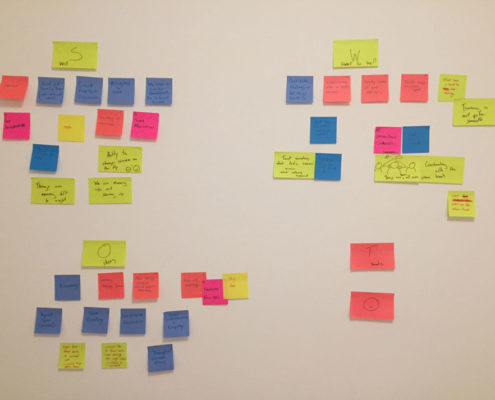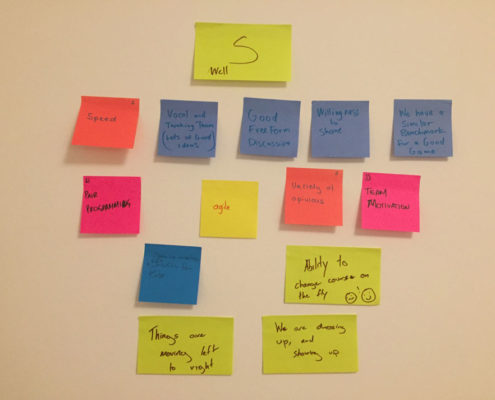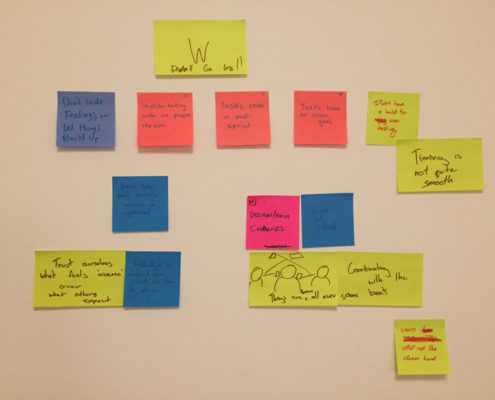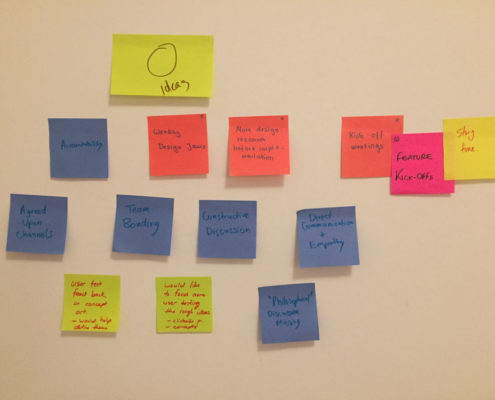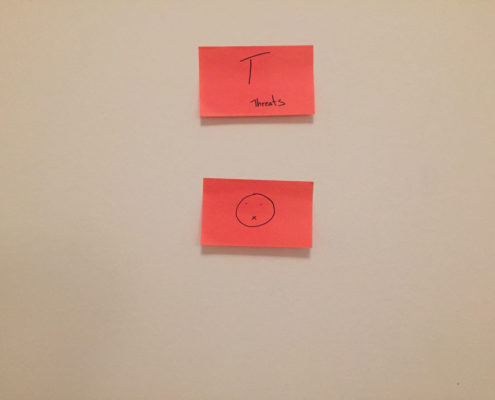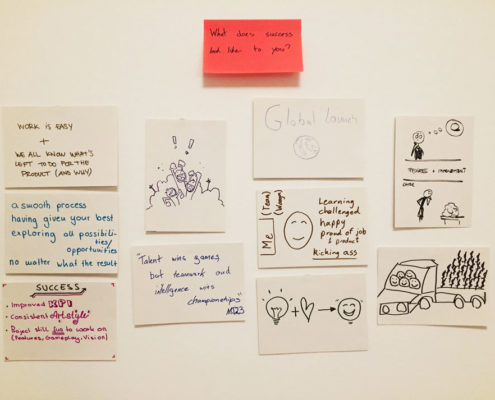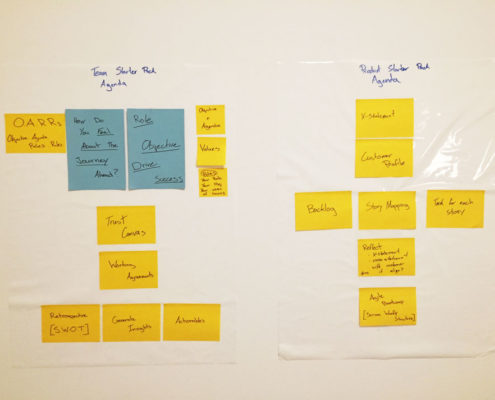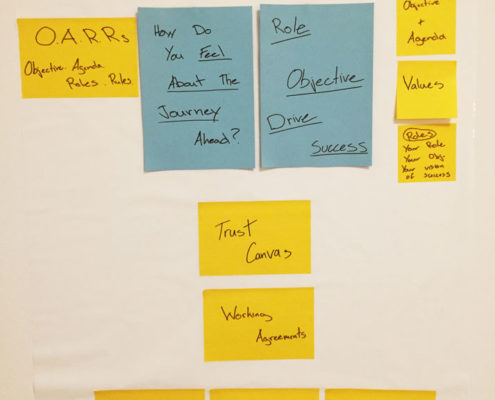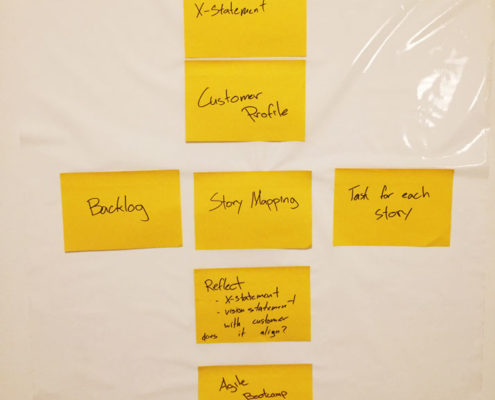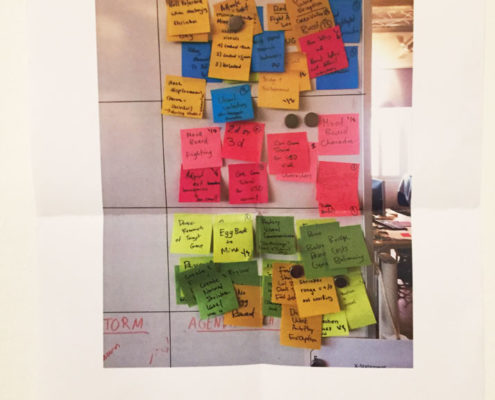As my wife and I are in the process of packing up all our things for our big move back to Vancouver, it also involves clearing many scraps of paper. I untangled clumps of post-its that I’ve kept for many years and it reminded me of the 5 reoccurring insights I had – varying from project observations to the tools that I have used.
I’ve kept these post-its for so long as they help me configure an effective mind-set to facilitate team discussions and influence a positive change as an agile coach.
I figured it would be good to document them here before throwing the physical ones into the recycling.
Clump #1: Team Values & Product Progress
A critical insight that I’ve gathered over the years was observing the quality of feedback that team members give each other. Whether it is at the start of the project or during intervals of production, it is important for a team to take some time to talk to each other about how they are working together and how they feel about the progress of their product.
This practise works wonders compared to a team that only reserves the discussion to the post-mortem as it allows the team to improve earlier and navigate their progress better.
The following pictures display common sample of a simple team/project retrospectives of a game team.
The clusters on the left display patterns of team focused feedback. There’s a variety of themes including:
- team values (face-to-face meetings, weekly structure)
- short concise feedback (no judgement, be clear)
- interaction & observation (PMs to be more structured, reducing Skype conversations)
The clusters on the right display more product focused feedback. We can find common topics/questions like:
- vision
- are we clear on what we are developing?
- can we describe it in a short sentence?
- do we know what to focus on first?
- do we know what to build next if we are faster than expected?
- weaknesses
- what makes our product special?
- “this particular feature does not work well because…”
Comments about product tend to have some overlap with the former evaluation of how the team is working together. However, the way I like to differentiate them is to use the set of product feedback to discuss the strategy of what to execute next (both short-term and long-term) based on what was delivered so far, rather than talking about how to improve team processes.
Sometimes a simple exercise like mapping these topics can help drive a very productive conversation. However, if the discussion doesn’t include solutions to problematic themes the team can feel limited. Therefore a standard SWOT analysis can help upgrade this simple structure to form clearer suggestions for improvements.
Clump #2: SWOT Analysis
I’ve used this structure a lot in the start of my agile coaching career because it has proven to be the most effective for retrospectives and team discussions. It can be used to discuss team progress, evaluating a product or even during ideation. I typically use it for team retrospectives.
The value of the exercise is to bring these individual opinions out in the open, accept them and get into a meaningful conversation on how to improve and more forward. It also provides a space to discuss about ideas and solutions to improve how the team works together.
The concept is simple. I ask each team member to fill out 4 post-its per quadrant to stick on the SWOT map.
- S = Strengths (what is good?)
- W = Weakness (what is bad?)
- O = Opportunities (ideas for improvements?)
- T = Threats (what will break us? what do you think will break us?)
The images of the expressions below are observation I have seen very often. Note: Although the expressions are very common in game development, I intentionally left out the “Threats” post-its as most of them are specific and sensitive to the team.
It is common for teams to feel that they fell short due to very basic mistakes but that is okay as it is part of the team-building process. As a coach, I feel it is our responsibility to not over-stress on the mistakes but to rather find the right communication style that will motivate the team to self-improve.
Clump #3: What does success look like to you?
It’s simple question that can bring draw out a lot of motivating imagery and goals can help spark a team. When you can help the team explain their idea of success to each other, a positive environment can be shaped especially if you convince them that they can help each other get to their goal.
As an exercise, I would pose the question to the group and limit them to two post-its that they can use to desrcibe to the group what success looks like to him/her.
Outcomes can vary from just plane bullet points to drawings. They can also vary from complex outcomes, like increased KPIs & making money, to more minimal ones, like just simply being proud of the product. Here’s are some examples that I gathered at a workshop.
Clump #4: Agenda for New Teams
When I’m asked to bootcamp a team on the foundation of agile development, I usually turn to my minimal agenda. Through the years, I found the right order of exercises that I split into two different themes:
- Team Foundation
- Product Backlog Building
In the following pictures you’ll see how I’ve split them and the order in which I conduct the exercises from top to bottom. Exercises that share a row means that they are grouped up to achieve a specific theme/goal.
Overall the starters workshop is very detailed and there is too much information to cover in this entry. In short, my objective is to build a healthy starting environment for teams and help them build the initial backlog that will enable them to start their project.
If you take a closer look, the team agenda is inspired by the Scrum Master (CSM) curriculum. Whereas, the product agenda is inspired the Scrum Product Owner (CSPO) curriculum.
For the complete breakdown, continue reading. Otherwise skip to the next clump. 😉
The breakdown of the workshops are as follows:
- Team Foundation
- OARRs (Objectives, Agenda, Roles, Rules)
- Full-team understanding of each member’s core competence
- Awareness of each member’s motivations
- Awareness of each member’s availability
- Buy-in on meeting practises
- Trust Canvas
- Collaborative understanding of what trust means to the group
- How to shape high trust within for the project
- Working Agreements
- Establish the first set of values/rules that the team believes will make them work effectively
- Team Retrospective
- Share insights how the current team works now
- Share insights how the members used to work before in other projects
- Find actionables that will enable the team to be high-performing
- OARRs (Objectives, Agenda, Roles, Rules)
- Product Backlog Building
- X-Statement
- Can the team describe their product as a catchy line?
- Customer Profile
- Does the team understand the core demographic
- Create a Customer Profile Poster
- Story Mapping / Customer Journey / Backlog
- Draw a line of customer’s daily journey
- Identify hot spots when the customer could use the product
- Identify user stories at each hot spot to build the backlog
- Revisit X-statement
- After fleshing out the vision, does the x-statement still make sense?
- Scrum Week Structure
- Simulate a Scrum Week as recommended by the book
- Shared understanding of initial week structure
- Guide the team on how they can change the structure to what works best for them
- X-Statement
Clump #5: Usual Retrospective Agenda
Here’s what my standard team retrospective agenda looks like. I’ve always valued using the kanban to structure my meetings to provide full transparency to the team and to hold each other accountable for keeping in the time limit.
The structure is based on the practise from the Agile Retrospective Book, which I reviewed here: http://www.alsinoy.com/2015/07/agile-retrospectives-book-breakdown/
I’ve learned to roll with this style and it always worked well. For any surprising turns that could occur at a meeting, I always keep in mind that the end goal is for the team to find a set of actionables that they can take to the next sprint to improve the way they work.
For a detailed breakdown of a typical retrospective, I recommend reading the above blog post. I’d also like to draw attention to how I added the time-box in the post-its below.
Bonus Clump: Signs of team success!
Wow! That was a lot of information after all. I’m glad if you’ve read this far. But if you skipped a lot of it, I hope you managed to get some useful tips.
I’ll end this post with a reminder that all this facilitation work pays off when you see that the team takes genuine pride in their work, celebrate the wins together and embrace the moments they collaborate to continuously improve and achieve great things.
This last picture was my vision of success.

